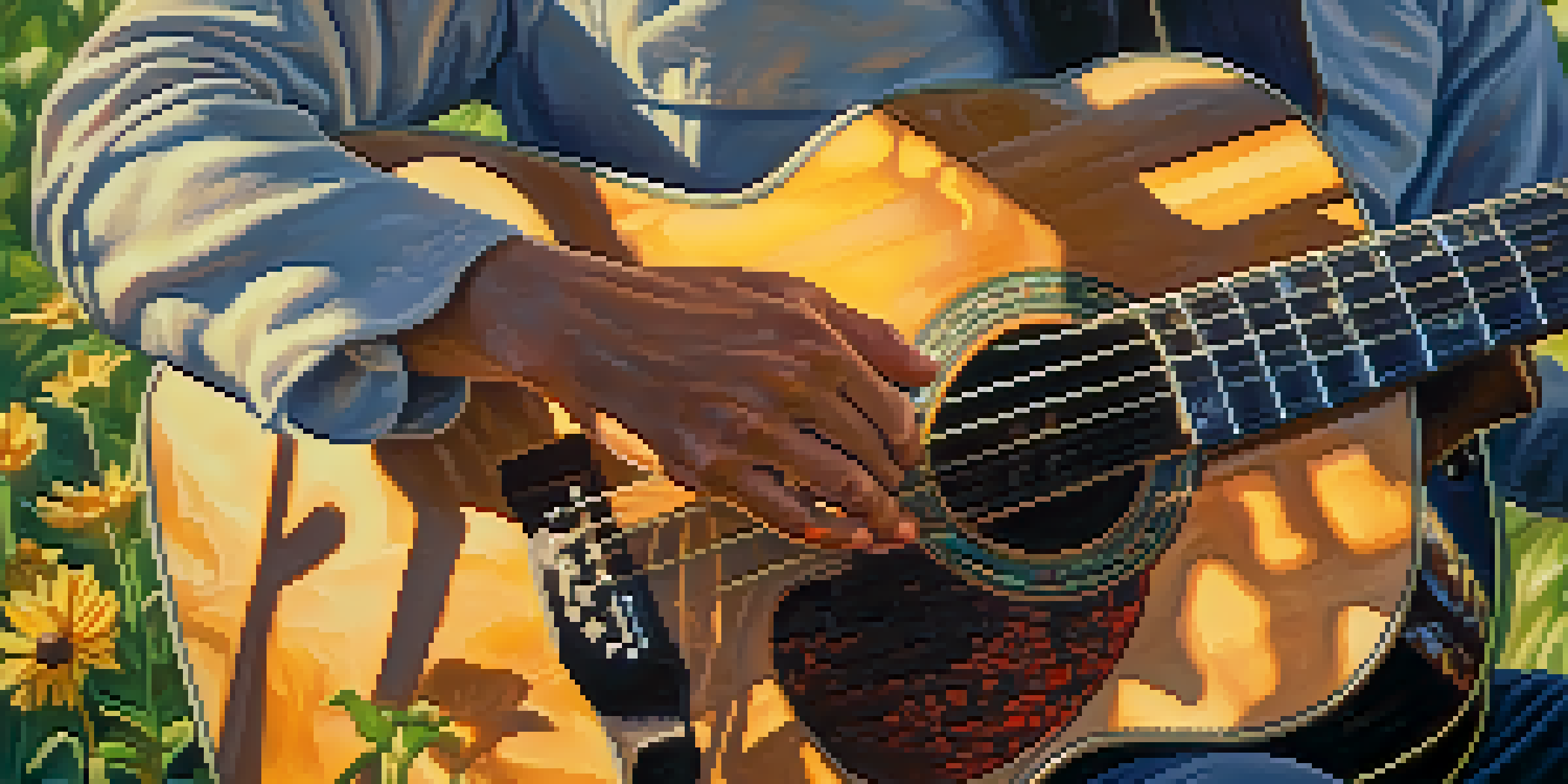Fingerstyle Guitar Techniques for Advanced Players

Understanding the Fundamentals of Fingerstyle Technique
Before diving into advanced techniques, it's essential to grasp the fundamentals of fingerstyle guitar. This style relies heavily on the independence of your fingers, allowing for intricate melodies and harmonies. By mastering basic finger placements and plucking patterns, you lay a solid foundation for more complex techniques.
Music is the shorthand of emotion.
Think of your fingers as a team, each with its unique role. The thumb typically handles the bass notes, while the index, middle, and ring fingers can play melody and harmony. This coordination is crucial; without it, the fluidity and richness of fingerstyle playing can be lost.
As you practice, focus on developing a relaxed hand posture and maintaining even timing. This will not only improve your sound quality but also prevent tension and fatigue during longer playing sessions. Remember, the journey to advanced fingerstyle begins with a strong grasp of the basics.
Exploring Alternate Tunings for Creative Expression
Alternate tunings can significantly expand your creative palette as an advanced fingerstyle player. By tuning your guitar to different pitches, you unlock unique voicings and chord shapes that can inspire fresh musical ideas. Popular alternate tunings like DADGAD or Open G offer distinctive sounds that standard tuning can’t replicate.

For instance, DADGAD is favored by many folk musicians for its rich harmonic possibilities. When you strum a simple chord in this tuning, you'll notice how it resonates differently, giving your music a new texture. This can lead to unexpected melodies that might not surface in standard tuning.
Mastering Fingerstyle Basics
Developing a strong foundation in finger placements and plucking patterns is crucial for advancing in fingerstyle guitar.
Experimenting with various tunings encourages you to think outside the box and can help you develop your signature sound. As you become comfortable with these tunings, you’ll find that they also enhance your improvisational skills, allowing you to create captivating pieces on the fly.
Incorporating Harmonics for Unique Melodic Layers
Harmonics are a magical addition to your fingerstyle repertoire, adding ethereal qualities to your playing. By lightly touching the string at specific points while plucking, you create bell-like tones that can complement your melodies beautifully. This technique can elevate your compositions to a whole new level.
The only way to make sense out of change is to plunge into it, move with it, and join the dance.
For example, you can use natural harmonics at the 5th, 7th, or 12th frets to add shimmering accents to a song. Integrating these harmonics into your arrangements can create a haunting atmosphere, perfect for solo performances or intimate settings. Imagine the blend of regular notes with these ethereal sounds; it’s truly captivating.
As you practice harmonics, experiment with different placements and combinations within your pieces. This not only enhances your fingerstyle technique but also challenges your creativity, encouraging you to think beyond traditional melodies and explore the sonic landscape of your guitar.
Fingerstyle Patterns: Expanding Your Rhythmic Vocabulary
Rhythm is the heartbeat of any musical piece, and in fingerstyle guitar, it takes on an intricate role. Advanced players should focus on expanding their rhythmic vocabulary through various fingerstyle patterns. By doing so, you can add complexity and interest to your performances.
Consider experimenting with syncopated rhythms, where the accent falls on off-beats rather than the usual downbeats. This can create a more lively and engaging feel in your music. For instance, try alternating between a steady bass line and varied melody lines that play off the main rhythm.
Exploring Creative Tunings
Using alternate tunings like DADGAD can inspire new musical ideas and enhance your improvisational skills.
As you incorporate different patterns, listen to how they change the dynamics of your playing. Some patterns might evoke a gentle lull, while others can drive the energy forward. The goal is to find a balance that enhances the emotional impact of your music, making it resonate with your audience.
Using Percussive Techniques to Add Groove and Depth
Percussive techniques are essential for advanced fingerstyle guitarists looking to add groove and depth to their sound. By incorporating body taps, slaps, and pops, you transform your guitar into a percussive instrument, creating a captivating rhythmic experience. This technique can elevate your solo performances by making them more engaging.
For example, try tapping your fingers on the body of the guitar while simultaneously playing a melody. This creates a layered sound that draws listeners in and keeps them captivated. The contrast of melody and rhythm can make even simple pieces sound complex and dynamic.
As with any technique, practice is key. Start slowly, ensuring clarity in both your melody and percussive elements before gradually increasing your speed. The result will be a rich, textured sound that showcases your advanced fingerstyle skills and keeps your audience on the edge of their seats.
Developing Your Own Style Through Improvisation
Improvisation is where your unique voice as a fingerstyle guitarist truly shines. Advanced players should embrace this skill to develop a personal style that reflects their musical identity. It allows you to experiment with melodies, harmonies, and rhythms freely, creating something entirely your own.
Begin by selecting a chord progression that resonates with you, then let your fingers explore different melodic lines over it. Don't be afraid to stray from conventional patterns or try unexpected variations. This spontaneity can lead to discovering new ideas that might transform your playing.
Improvisation for Personal Style
Embracing improvisation allows advanced fingerstyle guitarists to develop a unique voice and deeper emotional connection to their music.
As you practice improvisation, consider recording your sessions. Listening back can offer insights into your strengths and areas for improvement, helping you refine your style. Over time, you'll find that improvisation not only enhances your skill set but also deepens your emotional connection to the music you create.
The Importance of Ear Training for Fingerstyle Guitarists
Ear training is a vital skill for any advanced guitarist, especially in fingerstyle playing. Being able to recognize chords, intervals, and melodies by ear enhances your overall musicianship and allows for more fluid improvisation. It’s like having a built-in GPS for navigating through your musical journey.
Start by listening to your favorite fingerstyle pieces and try to transcribe them by ear. This practice sharpens your listening skills and helps you understand how different techniques are applied in context. Over time, you'll find it easier to replicate those sounds and even incorporate them into your own playing.

Additionally, ear training can significantly improve your ability to play with other musicians. When you can intuitively recognize changes in harmony or rhythm, you become a more versatile player. This skill not only enriches your playing experience but also opens the door to collaborative opportunities.